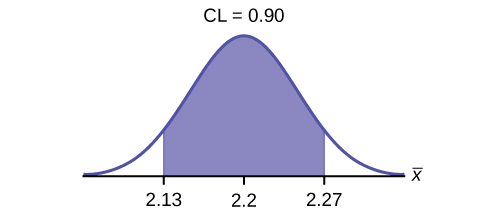| << Chapter < Page | Chapter >> Page > |
Identify the following:
In words, define the random variables X and .
X is the time in minutes it takes to complete the U.S. Census short form. is the mean time it took a sample of 200 people to complete the U.S. Census short form.
Which distribution should you use for this problem?
Construct a 90% confidence interval for the population mean time to complete the forms. State the confidence interval, sketch the graph, and calculate the error bound.
CI: (7.9441, 8.4559)

EBM = 0.26
If the Census wants to increase its level of confidence and keep the error bound the same by taking another survey, what changes should it make?
If the Census did another survey, kept the error bound the same, and surveyed only 50 people instead of 200, what would happen to the level of confidence? Why?
The level of confidence would decrease because decreasing n makes the confidence interval wider, so at the same error bound, the confidence level decreases.
Suppose the Census needed to be 98% confident of the population mean length of time. Would the Census have to survey more people? Why or why not?
Use the following information to answer the next ten exercises: A sample of 20 heads of lettuce was selected. Assume that the population distribution of head weight is normal. The weight of each head of lettuce was then recorded. The mean weight was 2.2 pounds with a standard deviation of 0.1 pounds. The population standard deviation is known to be 0.2 pounds.
Identify the following:
In words, define the random variable X .
In words, define the random variable .
is the mean weight of a sample of 20 heads of lettuce.
Which distribution should you use for this problem?
Construct a 90% confidence interval for the population mean weight of the heads of lettuce. State the confidence interval, sketch the graph, and calculate the error bound.
EBM = 0.07
CI: (2.1264, 2.2736)

Construct a 95% confidence interval for the population mean weight of the heads of lettuce. State the confidence interval, sketch the graph, and calculate the error bound.
The interval is greater because the level of confidence increased. If the only change made in the analysis is a change in confidence level, then all we are doing is changing how much area is being calculated for the normal distribution. Therefore, a larger confidence level results in larger areas and larger intervals.
In complete sentences, give an interpretation of what the interval in [link] means.
What would happen if 40 heads of lettuce were sampled instead of 20, and the error bound remained the same?
The confidence level would increase.
What would happen if 40 heads of lettuce were sampled instead of 20, and the confidence level remained the same?
Use the following information to answer the next 14 exercises: The mean age for all Foothill College students for a recent Fall term was 33.2. The population standard deviation has been pretty consistent at 15. Suppose that twenty-five Winter students were randomly selected. The mean age for the sample was 30.4. We are interested in the true mean age for Winter Foothill College students. Let
X = the age of a Winter Foothill College student.
= _____
30.4
n = _____
________ = 15
σ
In words, define the random variable .
What is estimating?
μ
Is known?
As a result of your answer to [link] , state the exact distribution to use when calculating the confidence interval.
normal
Construct a 95% Confidence Interval for the true mean age of Winter Foothill College students by working out then answering the next seven exercises .
How much area is in both tails (combined)? α =________
How much area is in each tail? =________
0.025
Identify the following specifications:
The 95% confidence interval is:__________________.
(24.52,36.28)
Fill in the blanks on the graph with the areas, upper and lower limits of the confidence interval, and the sample mean.

In one complete sentence, explain what the interval means.
We are 95% confident that the true mean age for Winger Foothill College students is between 24.52 and 36.28.
Using the same mean, standard deviation, and level of confidence, suppose that n were 69 instead of 25. Would the error bound become larger or smaller? How do you know?
Using the same mean, standard deviation, and sample size, how would the error bound change if the confidence level were reduced to 90%? Why?
The error bound for the mean would decrease because as the CL decreases, you need less area under the normal curve (which translates into a smaller interval) to capture the true population mean.

Notification Switch
Would you like to follow the 'Statistics i - math1020 - red river college - version 2015 revision a - draft 2015-10-24' conversation and receive update notifications?